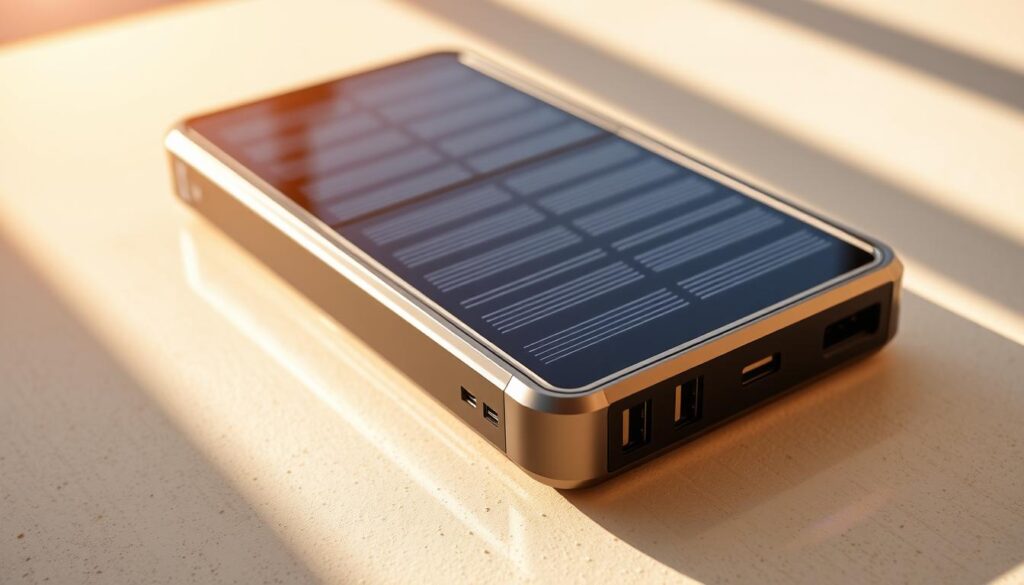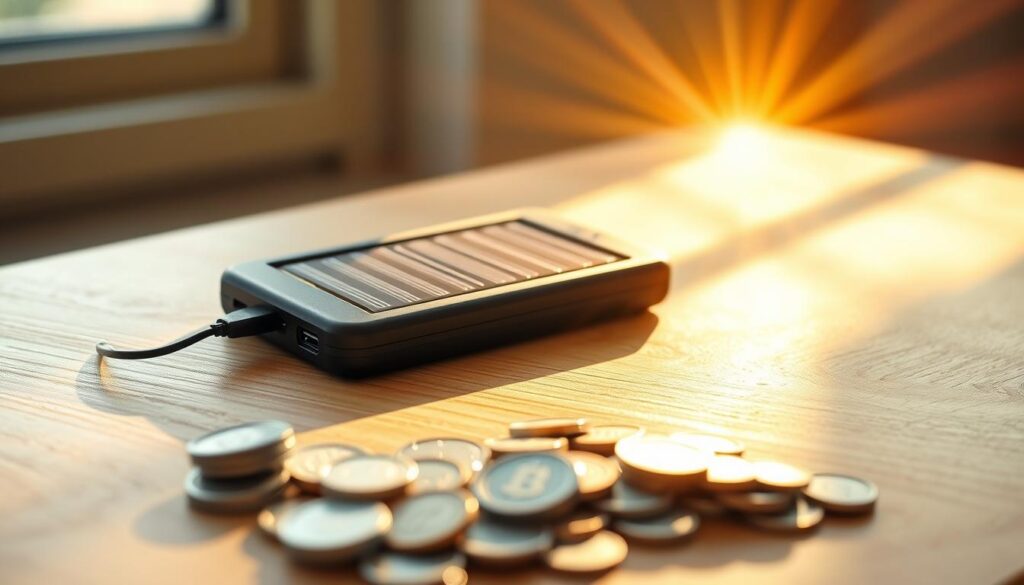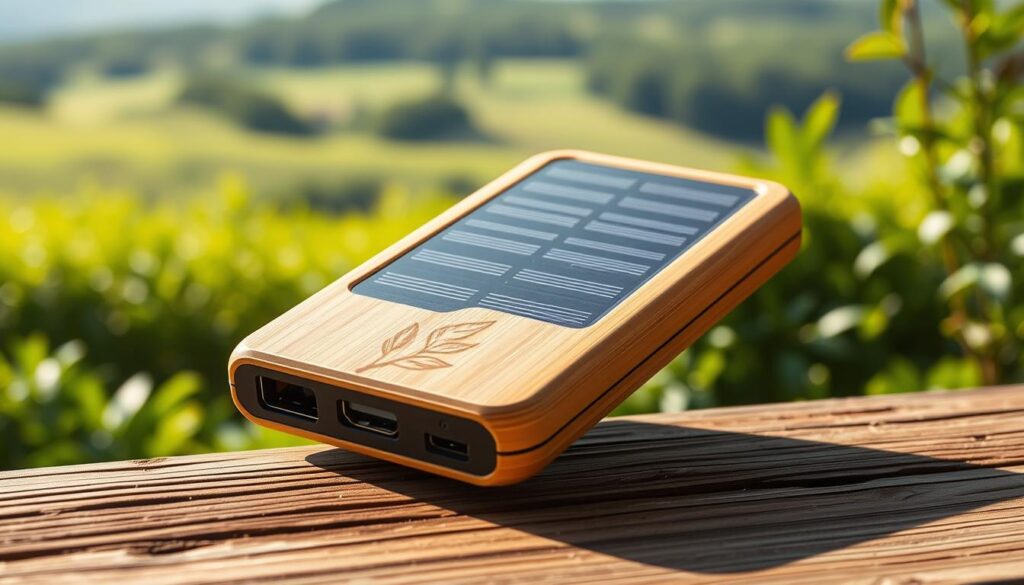Home solar power banks blend renewable energy with practical design to keep your devices charged anywhere. Brands like Goal Zero and Sunslice offer kits that pair solar panels with power banks, turning sunlight into usable energy for phones, cameras, and laptops. These compact systems provide reliable power during hikes, camping trips, or grid outages while cutting reliance on fossil fuels.
Key Takeaways
- Portable solar power banks combine solar panels with built-in batteries for on-demand energy.
- Goal Zero and Sunslice offer durable models like the Venture 35 or Flip 36, designed for outdoor and home use.
- IPX5 water resistance and multiple charging ports let you power up to three devices at once.
- Lithium-ion batteries store energy for days, even without sunlight.
- Options like Goal Zero’s Yeti 500X provide 500Wh capacity, powering 100W lights for five hours.
What Is a Home Solar Power Bank and How Does It Work?
A home solar power bank is like a personal energy vault that captures sunlight and stores it for later use. This system combines solar panels, batteries, and smart electronics to turn sunlight into usable power for phones, lights, or even home appliances. Imagine a sunny day: every ray captured becomes energy you can rely on, day or night.
The Science Behind Solar Energy Collection
Solar panels use photovoltaic (PV) cells to convert sunlight into direct current (DC) electricity. These cells work like tiny energy converters, shaking electrons to create a flow. Modern panels are smarter too—today’s tech can harness 20% more sunlight than older models, making every ray count.
Components of a Quality Solar Power Bank
Every solar battery charger system has key parts working together:
- Solar panels to collect sunlight
- Lithium-ion batteries (like LFP types) to store energy
- Charge controllers to protect batteries from overcharging
- Inverters that turn stored DC into alternating current (AC) for home use
- Output ports to power devices directly
Lithium-ion batteries, for example, last up to 10 years—twice as long as older lead-acid models. This durability means fewer replacements and lower long-term costs.
Converting Sunlight to Usable Power
When sunlight hits the panels, DC electricity flows to the battery. The inverter then acts as a translator, turning DC into AC for TVs, fridges, or lamps. The Lycan 5000 Power Box exemplifies this: its 4.8kWh capacity powers small appliances during outages. Smart systems even prioritize which devices get energy first, ensuring nothing runs out of juice.
Benefits of Investing in a Solar Panel Power Bank
A portable solar power bank offers more than just a charge for your phone. It’s a lifeline during outages, a travel essential, and a smart investment. Imagine having power for lights, medical devices, or laptops—even during storms. These devices combine reliability with convenience, fitting in a backpack or trunk.
- Emergency preparedness: Power essentials like refrigerators or sump pumps during blackouts.
- Cost savings: A rechargeable solar power bank slashes energy bills over time, paying for itself in 5–15 years.
- Environmentally friendly: Cuts reliance on fossil fuels, reducing carbon emissions by up to 80% annually.
Take the Lycan 5000 Power Box as an example. Its 4.8kWh capacity and 3500W output can power TVs, microwaves, or tools during outages. Plus, federal tax credits cover 30% of installation costs, making it affordable. Homeowners who installed solar systems saved an average of $1,500 annually on utilities.
These systems also boost home value. Buyers are willing to pay 4–6% more for homes with solar setups. And with lifespans of 10–20 years, lithium-ion batteries like the 12V 100Ah LFP model outlast cheaper alternatives. No more running to stores for disposable batteries—just sunlight and a portable solar power bank to keep life running smoothly.
“Our solar setup paid for itself in 7 years. Now we save $200/month on bills.” – Sarah M., Arizona homeowner
Whether for camping or outages, a rechargeable solar power bank delivers peace of mind. Pair it with tax incentives, long-term savings, and the satisfaction of cleaner energy. Your home—and the planet—will thank you.
Top Features to Look for in the Best Solar Power Bank
Selecting the best solar power bank requires evaluating key specs that balance performance and practicality. Start by checking battery capacity in mAh and power output in watts. A 10,000mAh model like the Goal Zero Venture 35 powers phones and small devices, while larger setups like the Jackery SolarSaga 100 (100W) handle high-demand gear.

Solar panel efficiency matters most. Compare monocrystalline panels, like the Goal Zero Nomad 10’s 7.5W output, against smaller panels that take 70+ hours to recharge. Look for models with real-world test scores—like the Renogy 100W Foldable’s 65W measured output in direct sun.
- Durability: IPX5 water resistance and drop-test ratings ensure survival in harsh weather.
- Ports & Speed: USB-C, wireless charging, and pass-through tech let you charge devices while recharging the bank.
Top models like the BioLite Solar Panel 100 (21.4V output) or FlexSolar 40W prioritize portability without sacrificing power. Avoid underperformers like the Hiluckey HIS025, which takes 7 hours to charge a 10,000mAh battery. Always check port count—opt for 3+ USB ports like those on the BigBlue SolarPowa 28.
Real-world data shows the Jackery SolarSaga 100 generates 68Wh/hour in direct sun, outperforming smaller panels. Prioritize brands with 10+ years of testing consistency like Goal Zero and BioLite.
Portable Solar Power Bank Options for Every Lifestyle
Modern solar power solutions cater to diverse needs, making clean energy accessible anytime, anywhere. Whether you’re a city commuter or a weekend explorer, the right portable solar power bank can adapt to your routine.
Compact Models for Daily Commuters
Urban lifestyles demand discreet tech. The Sunslice Commute Pro fits in a bag, delivering 10,000 mAh to charge phones and smartwatches. Light at 0.8 lbs, it’s ideal for daily use. Pair it with a mini solar panel for on-the-go charging.
High Capacity Solutions for Outdoor Enthusiasts
Adventure-ready gear like the Allpowers SP012 Solar Panel delivers 100W output, charging a 10,000 mAh battery in 6 hours. Its IP65 rating protects against dust and rain, making it a top-tier high capacity solar power bank for camping. Accessories include carabiners and cables for versatile setups.
| Model | Capacity | Use Case |
|---|---|---|
| Sunslice Commute Pro | 10,000 mAh | Urban commutes |
| Allpowers SP012 | 100W Solar + 10,000 mAh | Camping/outdoor trips |
| Goal Zero Venture 35 | 35,000 mAh | Emergency home backup |
Home Emergency Backup Systems
During outages, the Goal Zero Venture 35 powers essentials like lights and routers. Its 35,000 mAh stores enough energy for 20+ hours of device charging. Pair with a solar panel for continuous recharging. Spring sales offer up to 20% off on bundles over $500, with free shipping.
How a Rechargeable Solar Power Bank Saves You Money
Switching to a rechargeable solar power bank isn’t just eco-friendly—it’s a smart financial move. Let’s break down the numbers. A basic model starts at $30, while high-capacity options like the Power Bank 2000 cost up to $200. But the payoff comes quickly.

- Average U.S. households spend $110–$130 yearly on device charging. Solar power banks cut this by 20–30%.
- The Power Bank 2000’s 8,064Wh capacity can power essentials during outages, saving hundreds on hotel stays or lost food.
- With a 5–10 year lifespan, these banks outlast traditional chargers, reducing replacement costs by 70% or more.
Imagine this: Pairing the Power Bank 600 with two 200W solar panels fully charges in 3.5 hours. Over time, that’s hundreds saved annually. Plus, the federal Solar Investment Tax Credit (30% credit) slashes upfront costs. Even better, durable designs like the Power Bank 2000’s 18-month warranty (extensible to 3 years) ensure long-term reliability.
Users report slashing electricity bills by prioritizing solar-charged devices. A family using a Power Bank 2000 could recoup their investment in 6–18 months through reduced grid reliance. Solar’s free energy source means no more throwing money at disposable batteries or peak-hour electricity rates.
Every dollar spent on a rechargeable solar power bank is an investment. With expanding solar tech—like the Power Bank series’ rapid charging speeds—the switch becomes a no-brainer for budget-conscious, eco-aware households.
Eco-Friendly Power Bank Solutions: Reducing Your Carbon Footprint
Switching to an eco-friendly power bank is a smart step toward cutting waste and lowering environmental harm. Traditional batteries contribute to pollution through toxic chemicals and landfill waste, but solar-powered options offer a cleaner alternative.

Modern eco-friendly power bank brands like Goal Zero use recycled plastics and biodegradable materials. Their solar kits, such as the 500Wh model, pair solar panels with rechargeable lithium-ion batteries. These systems last up to 10 years, reducing the need for frequent replacements.
- Traditional batteries leak heavy metals into soil and water when discarded.
- Solar power banks like the Bluetti EP900 use lithium iron phosphate (LFP) batteries, which are safer and more sustainable than lead-acid alternatives.
- Goal Zero’s 200Ah LFP battery offers 10-year warranties, outperforming disposable battery lifespans by 5-10x.
Lifecycle studies show solar systems offset carbon emissions within 1-2 years of use. Over a decade, a single eco-friendly power bank prevents over 500 pounds of CO2 emissions compared to grid power. Plus, brands like Renogy prioritize recyclable packaging and carbon-neutral shipping.
By choosing solar solutions, you join a growing movement. In 2024, solar battery sales rose by 40%, with the Bluetti EP900 topping CNET’s 2025 rankings. Every switch to solar helps reduce America’s 3 billion annual battery disposals—making clean energy accessible without sacrificing convenience.
Off-Grid Solar Power Bank Applications for Home and Beyond
Off-grid solar power banks like the BLUETTI AC200MAX aren’t just for phones—they’re lifelines for modern life. These systems power laptops, lights, and tools anywhere, turning sunlight into usable energy. Imagine working remotely from a mountain cabin or keeping critical devices running during a hurricane. Sunslice’s off-grid solar power bank solutions make this possible.
- Remote Work: BLUETTI’s EB3A solar generator fuels work setups in national parks or deserts, offering 200W continuous power.
- Emergency Prep: The AC300’s modular design scales to power sump pumps or medical devices during grid failures.
- Outdoor Adventures: Campers use portable models like the AC200MAX to charge drones or lanterns during multi-day trips.
- Humanitarian Aid: Organizations deploy rugged solar systems to power clinics and schools in rural areas without grid access.
BLUETTI’s IP65-rated devices withstand rain and dust, making them ideal for farms or construction sites. For homes, the Enphase 10kWh Ensemble Package pairs with solar kits, storing energy for evening use. These systems even help California residents cut bills by $300+ annually via NEM 3.0 rate advantages.
Whether you’re a vanlifer, researcher, or disaster responder, off-grid solar power banks redefine independence. From tiny homes to disaster zones, these systems ensure power stays in your hands—not the grid.
Setting Up Your Home Solar Power Bank System
Ready to install your solar panel power bank? Follow these steps to maximize efficiency and longevity. Start by selecting the best location for your panels. Southern-facing rooftops or open spaces with minimal shading work best in the U.S. Use adjustable mounts to tilt panels seasonally—15° in winter, 45° in summer.
Optimal Placement for Maximum Sun Exposure
- Face panels south in northern hemispheres for year-round sun capture
- Mount on roofs, ground racks, or pole systems with 6-8ft spacing between panels
- Check local building codes before drilling permanent installations
Maintenance Tips for Longevity
| Factor | Lithium (Expert Power) | AGM |
|---|---|---|
| Lifespan | 10+ years | 2-5 years |
| Cost Over 10 Years | $3,500 | $9,000 |
| Charge Cycles | 2,500-7,000 | 300-500 |
Use a multimeter monthly to check 12V batteries at 12.6V+ when fully charged. Wipe dust off panels quarterly with a microfiber cloth and water—no harsh chemicals. Store in 50-80°F ranges using climate-controlled enclosures in extreme climates.
Integrating with Your Existing Power Setup
| Component | Specification |
|---|---|
| Battery Bank | 5 Expert Power 100Ah LiFePO4 units |
| Inverter | 3,000W Renogy Inverter Charger |
| Charge Controllers | 2x 40A Renogy MPPT controllers |
| Wiring | 2AWG battery cables / 10AWG controller wiring |
Connect to home circuits using a transfer switch for grid backup. Pair with solar panels rated at least twice the battery capacity. Example: 200Ah bank needs 400W panels. Hire licensed electricians for grid-tied systems requiring 240V connections.
Regular maintenance checks using a volt meter ensure safe operation. Avoid discharging below 50% capacity to preserve battery health. Proper setup ensures your solar panel power bank becomes a reliable energy partner for decades.
Real User Stories: How Americans Are Utilizing Solar Power Banks
Explore how the best solar power bank transforms everyday life. From mountain trails to disaster prep, real users share their experiences:
- Sarah’s Rocky Mountain Adventures: Hiker Sarah uses the Mango Power E to power GPS and radios during multi-day trips. “Its 3.5 kWh capacity keeps me connected without extra weight,” she says.
- Michael’s Storm Prep: After Hurricane Irma, Florida’s Michael relies on a 3 kW system to power medical devices. “Saved $200 yearly on energy bills too.”
- Linda’s Remote Office: Arizona’s Linda runs a mobile workspace with a portable model, cutting grid reliance and costs.
- Iowa Farm Efficiency: A farming family powers sensors and tools, reducing diesel generator use by 40%.
| Name | Location | Use Case | Model |
|---|---|---|---|
| Sarah | Colorado | Hiking | Mango Power E |
| Michael | Florida | Emergency Backup | 3 kW System |
| Linda | Arizona | Remote Work | Portable 1,000Wh Model |
“The Mango Power E handled -20°F temps during winter camping—I never doubted it.” – Iowa Farmer
These stories show how the best solar power bank adapts to lifestyles. Whether for adventure, emergency, or daily savings, these systems deliver reliability. Over 700,000 U.S. households now rely on such setups, proving solar tech works beyond theory.
Conclusion: Embracing Solar Technology for a Sustainable Future
Home solar power banks are no longer a distant dream but a proven solution shaping modern energy use. The U.S. solar capacity has skyrocketed from 0.34 gigawatts in 2008 to over 97.2 gigawatts today—a 28,500% leap. This growth highlights how solar technology is becoming a cornerstone of energy independence. A well-designed system can slash electricity bills by up to 40%, offering tangible savings while reducing reliance on fossil fuels.
Choosing an eco-friendly power bank isn’t just about cutting costs. It’s about resilience. During outages, a home solar power bank ensures essentials like refrigerators or medical devices stay powered for 24 hours. Lithium-ion models deliver long-lasting performance, while advancements like Sunslice’s portable chargers show how solar tech adapts to daily needs. These innovations prove reliability and affordability go hand in hand.
The future is bright. By 2030, solar could supply the most electricity globally as costs drop and efficiency rises. For households, starting small works best. A compact eco-friendly power bank can recharge phones on camping trips, while larger setups support full-time solar use. Even modest steps, like upgrading to a lithium battery system, contribute to cutting carbon footprints.
With rooftop solar now powering over 40% of U.S. electricity, the shift to solar energy storage is unstoppable. Whether prioritizing cost savings, emergency readiness, or environmental stewardship, a home solar power bank aligns with today’s energy goals. Explore options like Sunslice’s portable chargers or assess your kWh needs to size a system. Every choice toward solar tech moves us closer to a cleaner, more resilient energy future—starting today.
